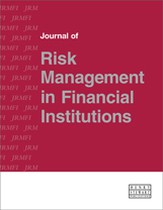Risk-neutral versus objective loss distribution and CDO tranche valuation
Abstract
This paper considers the risk-neutral loss distribution as implied by index collateralised debt obligation (CDO) tranche quotes through a ‘scenario default rate’ model as opposed to the objective measure loss distribution based on historical analysis. The risk-neutral loss distribution turns out to assign greater probability to large realisations of the loss with respect to the objective distribution, thus implying the well-known presence of a risk premium. In the spirit of Elton et al. (2001), the paper measures this premium, regressing the tranche excess returns against the three Fama-French factors, augmented by the credit index excess returns. However, on the basis of the limited available sample data, it finds no evidence of a significant risk premium. Following Tarashev and Zhu (2007), the paper quantifies the correlation premium, pricing CDO tranches and indices under two distributions: risk-neutral and objective. Instead of building a time nonhomogeneous default dependency as per Tarashev and Zhu, the paper assumes a time-homogeneous default correlation, as can be found in the S&P CDO Evaluator. En passant, the paper analyses the implied risk-neutral default-rate distributions calibrated from April 2004 through April 2006, noting the persistence through time of the distinctive ‘bump’ in the distribution tail.
The full article is available to subscribers to the journal.
Author's Biography
Roberto Torresetti is responsible for the synthetic structured credit derivatives business at BBVA. He was previously a senior credit derivatives modeller at Banca IMI and equity derivatives analyst at Lehman Brothers. He was also a quantitative fund manager at San Paolo IMI Asset Management. He holds a bachelor’s degree in economics from Università Bocconi in Milan and completed his MA in economics at Università Bocconi and MS in financial mathematics at the University of Chicago.
Damiano Brigo obtained a PhD in stochastic filtering with differential geometry from the Free University of Amsterdam, following a BSc in mathematics from the University of Padua. Since July 2007, he has been Managing Director and Global Head of the Quantitative Innovation team at Fitch Solutions, London. He is also currently Visiting Professor at the Department of Mathematics at Imperial College, London. He is author of the book ‘Interest Rate Models: Theory and Practice’ (Springer-Verlag), and his academic and practitioner-oriented articles have been published in financial modelling, probability and systems theory journals. Damiano is Managing Editor of the International Journal of Theoretical and Applied Finance.
Andrea Pallavicini has a degree in astrophysics and a PhD in theoretical and mathematical physics from the University of Pavia. He is currently Head of Financial Engineering at Banca Leonardo in Milan. Over the years, he has written a number of academic and practitioner-oriented articles on financial modelling, theoretical physics and astrophysics. He has taught master’s courses in finance at the universities of Pavia and Milan. His main contributions in finance concern dynamical loss models, risk-neutral evaluation of counterparty risk, smile modelling in the swaption market, and pricing of exotic equity and/or interest-rate derivatives.
Citation
Torresetti, Roberto, Brigo, Damiano and Pallavicini, Andrea (2009, March 1). Risk-neutral versus objective loss distribution and CDO tranche valuation. In the Journal of Risk Management in Financial Institutions, Volume 2, Issue 2. https://doi.org/10.69554/OMTF2480.Publications LLP
